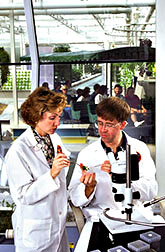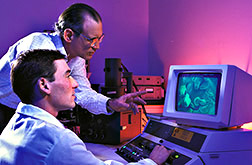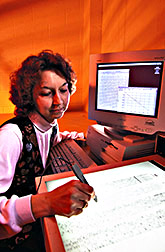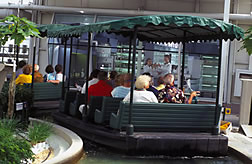Venture Into Agricultural Science At Disney World
 Epcot’s Lexie McKently and ARS horticulturist John Cordts plan improved methods for adding new genes to peaches. (K7137-18) |
Mickey and Minnie Mouse, Naia the baby dolphin, and the Magic Kingdom Park are not the only exciting attractions at Walt Disney World Resort near Orlando, Florida.
Behind a glass wall at Epcot, ARS horticulturist John Cordts works magic with tissue-cultured peach plants in a laboratory that boasts the highest possible visibility.
"It's a unique work environment," he says. "Every minute or so, about 40 people gaze into my lab."
Cordts hopes to transform the genetic makeup of peaches so that the fruit can ripen on the tree longer, yet stay firm enough for shipping. This would make for a juicier, better tasting peach in the produce bin. The project is part of a collaborative research effort that has been ongoing for several years.
The lab is located in The Land at Epcot, a 2-acre, intensive food crop production and research facility presented by Nestlé USA. The Land's main attraction is a 15-minute boat ride through a series of greenhouses showcasing agricultural research and production systems that emphasize sustainable agriculture. Each day, thousands of guests ride by the USDA-ARS-sponsored lab to see scientists conducting state-of-the-art agricultural research.
"Our main objective here is to communicate the science of agriculture. We do this by showcasing various tools—such as biotechnology—and our important world food and fiber crops," says Lexie McKently. She manages the biotechnology program at The Land.
 Horticulturist Ralph Scorza (top) and technician Kevin Webb use scanning electron microscopy to inspect a growing tip, or meristem, of a peach twig. (K7261-3) |
Before 1995, McKently was working on peanut transformation under the joint research program with USDA-ARS. Since then, the focus has been shifted to genetically altering peaches.
The collaboration involves the ARS Appalachian Fruit Research Station in Kearneysville, West Virginia, where scientists have isolated a gene that could alter the ripening characteristics of peaches. This gene could allow the fruit to be picked ripe from the tree while retaining enough firmness to withstand shipment.
Before assignment to Disney, Cordts was based at the Kearneysville lab.
Horticulturist Ralph Scorza and molecular biologist Ann Callahan have been working for several years at Kearneysville on improving the quality of supermarket peaches.
 Technician Linda Dunn analyzes DNA sequences of peach ACC oxidase that regulates fruit ripening. (K7260-2) |
“In addition to supplying the gene, we give John and other Epcot scientists technical support for this work,” Scorza says. “We’re fortunate to have this cooperative research with Disney, because Florida's warmer temperatures and longer growing season will help the newly transformed peach trees bear fruit earlier."
Callahan says that the gene provided to Cordts codes for the peach fruit enzyme ACC oxidase that is crucial to ripening. Inserting the gene backwards should drastically decrease its effect.
"This enzyme is essential for the last step of ripening, when most softening occurs," Callahan says. "If we can slow down that final step, it would give the peach more time to stay on the tree without becoming too soft to ship."
This would delay ripening and increase shelf life, yet maintain the fruit's taste and appearance. Even a few more days of natural ripening on the tree can make a significant difference in the flavor of a peach.
At Epcot, Cordts will use two methods to insert the gene into tissue-cultured plants:
"With a gene gun, we'll fire gold particles that are coated with DNA containing the gene into shoot tips of several different peach varieties," he explains. "We'll also insert the new gene with Agrobacterium tumefaciens, a bacterium commonly used in genetic engineering."
It could take from 3 to 6 months to determine whether or not plants are carrying the new gene. By then, the shoot tips will be young trees, ready for the greenhouse. But it will be a couple of years more before they bear fruit, Callahan says.
“This means field testing is still a few years away. At that time, we’ll work with USDA’s Animal and Plant Health Inspection Service for permits to test the genetically altered peach trees." -- By Doris Stanley, ARS.
Ralph Scorza and Ann Callahan are at the USDA-ARS Appalachian Fruit Research Station, 45 Wiltshire Rd., Kearneysville, WV 25430; phone (304) 725-3451 ext. 322.
"Venture Into Agricultural Science At Disney World" was published in the July 1996 issue of Agricultural Research magazine.







